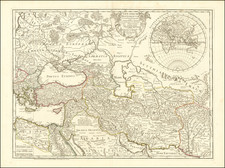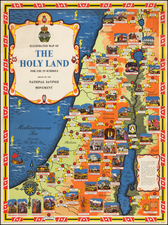Rare sea chart of Cyprus and the neighboring coasts, which was apparently made up and added to a Gerard Van Keulen Sea Atlas, here offered with two pages of text which apparently accompanied this curious chart.
The chart consists of the lower right section of the Johannes Loots / Gerard Van Keulen Sea chart of the Eastern Mediterranean, Nieuwe Pascaard van t' Tweede gedeelte der Middelansche Zee Tusschen t' I. Malta en Alexandretta . . . (with title repeated in English, French & Italian), with an added border using other parts of the chart.
The Loots / Van Keulen Sea Charts are of the utmost rarity. Because the title is not present, it is not possible to determine whether the chart is from a Johannes Loots edition of the map or a Gerard Van Keulen edition. The chart is illustrated in Zacharkis (1803/1186) and attributed to Gerard Van Keulen, although it is certainly one of the charts acquired by Van Keulen from Loots (see below).
Johannes Loots (1665 - 1726) was a publisher of sea charts who was active from the 1693 until his death in 1726. Loots began his career as an apprentice to Hendrick Doncker and later set up his own shop on Nieuwebrugsteeg in Amsterdam,in 1693. Between 1695 and 1698, Loots, Claes de Vries (a surveyor-cartographer) and Antoni de Winter (an engraver) entered into a joint venture to produce 200 sea charts on a Mercator Projection (Van Keulen Cartography, p 46). The plans were advertised in the Amsterdamsche Courant in August and October 1698 and several charts offered separately. However, the venture only produced 120 charts (Van Keulen Cartography, p. 47), and the partnership dissolved in 1707, with Claas de Vries selling at least 17 charts, including 16 large plates of the English Channel and a smaller plate of the Hull River, to Gerard Van Keulen on September 24, 1707 for 374 guilders) (Van Keulen Cartography, p. 16).
In 1696, Loots published a pirated group of charts of the Baltic, originally published by Swedish chart maker Peter Gedda in 1694. Loots published the Gedda charts under the name Paskaertboek van de Noord-en Oost-zee. Gedda would later file suit against Loots to block the publication. It would seem probable that the present chart was derived from the information first published by Gedda, although the map does not appear to be one of the pirated charts.
In 1707, Loots sold 100 charts on a Mercator Projection to Gerard Van Keulen. In 1707, Loots would appear to have purchased the plates of Jacob Robijn, which included the charts originally engraved by Arent Roggeveen for his Burnng Fen. These include a rare set of charts of the North American and Caribbean Coastlines, which were a significant improvement over the contemporary sea charts issued by Van Loon and Goos (for whom Roggeveen had originally made the charts).
At some point, he or his widow must have re-acquired the plates, as his widow and her brother, Isaac Swigerts, continued to publish later editions of some of the charts until 1750, when Swigerts,sold the remainder of the Loots charts to Johannes Van Keulen II. These plates were re-engraved to include the Van Keulen name thereafter. At the time of his death, the inventory notes The inventory of Isaac Swigters estate includes 10,816 various maps, presumably, his unsold inventory. During the life of Loots sea charts, it is known that some of the charts were copied by both Seller and Grierson.
While an inventory of Loots shop included 464 copperplates, the number of plates known to have been published by Loots is far fewer and it would appear that this inventory included multi-plate charts and non-cartographic material.
The Van Keulens were a family of chartmakers and publishers. The firm, In de Gekroonde Lootsman (In the Crowned Pilot), was founded in 1678 by Johannes van Keulen (1654-1715). Van Keulen originally registered his business as a vendor of books and instruments (specifically cross-staffs). In 1680, however, he gained a privilege from the States of Holland and West Friesland for the publication of pilot guides and sea atlases.
In that year, van Keulen released his Zee-Atlas (Sea Atlas), which secured him a name in the competitive maritime publishing market. In 1681, he published the first volume of Nieuwe Lichtende Zee-Fakkel (New Shining Sea Torch). This would be the first of an eventual five volumes originally published between 1680 and 1684. A sixth volume was added in 1753. The Zee-Fakel won van Keulen lasting fame. The atlas had charts compiled by Claes Jansz Vooght and artwork from Jan Luyken. It proved immensely popular and was reprinted until 1783. There were translations in French, English, Spanish, and Italian.
The late-seventeenth century was an auspicious time to enter the maritime chart business. Previous industry leaders had either closed shop, died, or retired, leaving space for a new competitor. Van Keulen proceeded to buy up the stock and privileges of several maritime publishing firms; the most notable was the stock of Hendrik Doncker, acquired in 1693.
Johannes’ son, Gerard (1678-1726) took over the business upon his father’s death. Gerard was a skilled engraver and mathematician. His talents were noticed, as in 1706 he was named as Hydrographer to the Dutch East India Company (VOC).
In turn, Gerard’s son Johannes II (1704-1770) came to run the shop. He was also tied to the VOC, and his role as their chartmaker allowed his charts to be considered as quasi-official government documents. It is with access to formerly clandestine VOC geographic knowledge that Johannes the Younger was able to add a sixth volume to the Zee-Fakkel, which covered the East Indies. Johannes also continued to sell instruments, including the recently-invented Hadley’s Quadrant from 1744.
When Johannes II died in 1770, his widow ran the business in his stead, aided by her two sons, Cornelis Buys (1736-1778) and Gerard Hulst (1733-1801). Now a century old, the family business had extended to include an anchor factory. After Cornelis died in 1778, Gerard took on the management of the firm alone. He oversaw the introduction of sextants to their inventory and published the Dutch Nautical Almanac beginning in 1788. Annual editions appeared until 1885. Gerard also served as an original member of the Dutch Commission for Longitude at Sea from 1787.
Gerard’s widow ran the business for nine years after his death, when their son, Johannes Hulst, started to lead the firm in 1810. After his death in 1844, the firm passed out of family hands and into the control of Jacob Swert, a skilled cartographer who had worked for the business for two decades. He passed the work to his son, another Jacob, in 1866. By the mid-nineteenth century, the conversion from sail to steam had diminished the size of the market for charts. Fewer sailors needed fewer maps, charts, and instruments. In 1885, after 207 years in business, In de Gekroonde Lootsman closed its doors and auctioned its stock.









![A New Map of the Eastern Parts of Asia Minor Largely taken as Also of Syria, Armenia, Mesopotamia &c . . .Dedicated to his Highness William Duke of Glocester [shows Cyprus]](https://storage.googleapis.com/raremaps/img/small/90579.jpg)
![[ Thessaloniki / Thermaic Gulf ] Die Landschaft Macedonien Nro. 17](https://storage.googleapis.com/raremaps/img/small/102208.jpg)
![Suite de la Genealogie ou Chronologie des Rois Patriarches et Prophetes du troisieme Periode du Monde. [Cyprus]](https://storage.googleapis.com/raremaps/img/small/91749.jpg)


![[ Tribes of Zabulun Issachar, Manasseh ] Tribus Zabulon, Isachar, et, Dimidia Manasse altera, hoc est illae Terrae Sanctae regiones . . .](https://storage.googleapis.com/raremaps/img/small/95602.jpg)